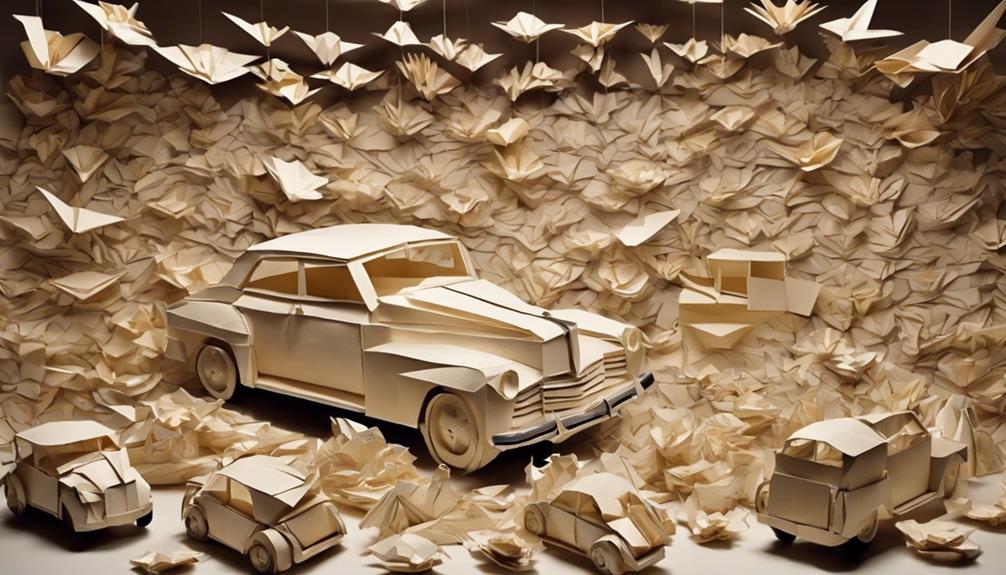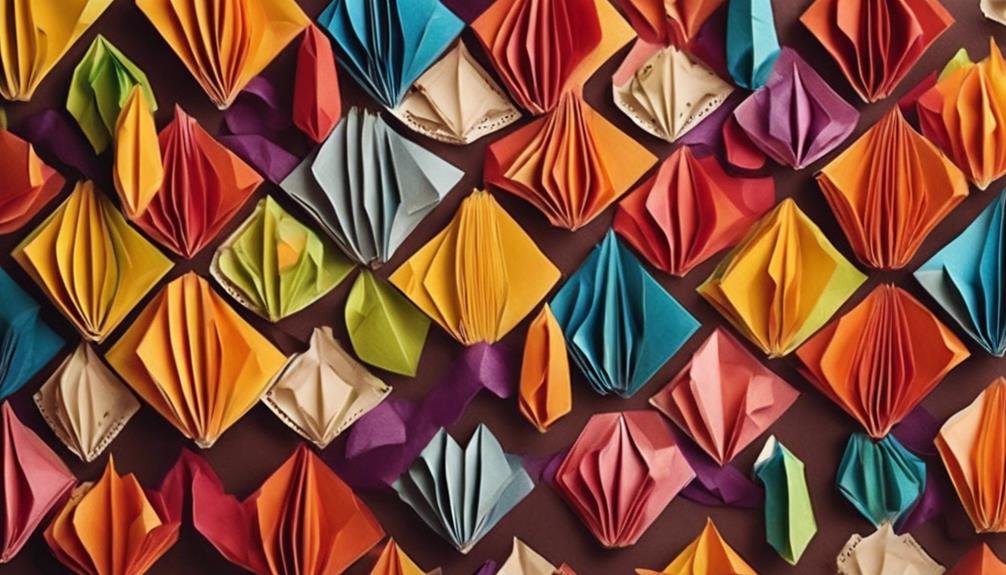Tyeb Mehta's groundbreaking paintings, characterized by bold brushstrokes and rich symbolism, have captivated the global art scene. His fusion of Indian and Western modernism showcases intense narratives that resonate with audiences. Mehta's art leaves an indelible mark through its profound storytelling and unique style, challenging traditional norms and fostering innovation. Despite controversies over themes of violence, his work sparks debates and scrutiny, underscoring its impactful nature. Mehta's masterpieces like 'Kali' series and 'Gesture' continue to inspire contemporary artists worldwide. Their exploration of Indian mythology and folk art sets a benchmark in the art world, inviting deeper exploration.
Key Takeaways
- Bold brushstrokes and intense colors evoke powerful emotions.
- Themes of struggle and triumph in Indian mythology captivate viewers.
- Fusion of Indian symbolism with Western modernism creates impactful art.
- 'Kali' series and 'Celebration' painting showcase profound narratives.
- Mehta's paintings challenge conventional norms, leaving a lasting impression.
Early Life and Influences
Tyeb Mehta's early life and influences shaped his artistic journey, laying the foundation for his groundbreaking work in the art world. Born in Kapadvanj, Gujarat, India in 1925, Mehta honed his skills at the prestigious Sir J.J. School of Art in Mumbai before venturing to London in 1959 on a scholarship. Influenced by Western modernist movements, he returned to India in the mid-1960s and played a pivotal role in the formation of the Progressive Artists Group.
Mehta's exposure to Western modernist movements during his time in London left an indelible mark on his artistic style. His unique interpretation of these influences, combined with his immersion in the vibrant art scene of India, set the stage for his innovative approach to art. His iconic 'Kali' series, characterized by bold colors and strong lines, emerged as a reflection of his distinct artistic vision.
Through his work, Mehta aimed to create a universal language that bridged cultures and transcended boundaries, drawing inspiration from Indian mythology and folk art to convey themes of violence and struggle.
Evolution of Style

Tyeb Mehta's artistic evolution is marked by bold brushstrokes and a dynamic color palette, showcasing a departure from traditional techniques.
His use of vibrant hues and strong lines in paintings like the 'Kali' series signified a shift towards a more expressive style.
Mehta's unique approach to incorporating diagonal shapes and intense colors set him apart as a trailblazer in the sphere of Indian modern art.
Bold Brushstrokes
Evolution brought a transformation in Tyeb Mehta's style, prominently marked by the emergence of bold brushstrokes in his paintings. These brushstrokes, influenced by Western modernist movements, became a defining feature of Mehta's artistic expression, setting him apart in the School of Art.
3 key aspects of Tyeb Mehta's bold brushstrokes:
- Influences from Western Modernist Movements:
Mehta's time in London exposed him to the innovative techniques of modern art, inspiring the development of his signature bold brushstrokes.
- Iconic 'Kali' Series:
Mehta's 'Kali' series exemplifies his use of strong lines and vibrant colors, showcasing the power and intensity conveyed through his bold brushwork.
- Capturing Intensity:
Through bold brushstrokes, Mehta effectively captures themes of violence and struggle in his paintings, creating a visual language that resonates with the viewer on a profound level.
Mehta's mastery of bold brushstrokes, infused with abstract and expressionistic elements, creates a dynamic and compelling visual narrative that continues to captivate audiences worldwide.
Dynamic Color Palette
With a deliberate shift in his artistic approach, Tyeb Mehta's dynamic color palette underwent a significant evolution throughout his career. Initially known for his bold and vibrant use of primary colors like red, blue, and yellow, Mehta's paintings exuded intensity and passion reminiscent of artists like Francis Bacon.
However, as his artistic journey progressed, Mehta's color palette transformed towards more restrained and subtle tones. His later works showcased a refined understanding of earthy and muted shades, reflecting a deeper introspection and contemplation in his artistry.
This evolution in Mehta's color choices not only mirrored his personal growth but also allowed him to convey a wide range of emotions and themes in his paintings. By embracing a more nuanced approach to color, Mehta demonstrated a mastery that captivated viewers and established him as a significant figure in the field of Indian art history.
Symbolism in Art

Tyeb Mehta's artwork is rich with symbolism, offering viewers an opportunity to decipher hidden meanings and engage in visual storytelling through the language of symbols.
By incorporating elements like vibrant colors and intricate details, Mehta's paintings serve as intricate narratives that go beyond mere aesthetics, inviting audiences to explore deeper layers of interpretation within his masterpieces.
Through the use of symbols, Mehta communicates profound messages that resonate with themes of culture, politics, and spirituality, captivating audiences with the complexity and depth of his artistic vision.
Hidden Meanings in Art
In art, symbolism plays a significant role in conveying deeper meanings and messages beyond the surface imagery. Tyeb Mehta's painting 'Durga Mahishasura' exemplifies this through intricate symbolism that goes beyond mere visual representation.
Here are three key aspects that highlight the hidden meanings in Mehta's artwork:
- Triumph of Good Over Evil: The portrayal of goddess Durga defeating the demon Mahishasura symbolizes the eternal battle between good and evil, showcasing themes of victory, righteousness, and justice.
- Cultural and Patriotic Symbolism: The vibrant colors resembling India's national flag not only add a patriotic touch but also infuse the artwork with cultural significance, reflecting Mehta's roots and influences.
- Complex Symbolism of Power and Knowledge: The use of multiple hands and implements for the goddess, along with the hybrid form of the Buffalo demon, conveys nuanced symbolism representing power, knowledge, and the perpetual struggle between light and darkness in a visually striking manner.
Visual Storytelling Through Symbols
Symbols in art serve as powerful tools for visual storytelling, conveying intricate meanings and messages beyond mere imagery and colors. Renowned artist Tyeb Mehta masterfully incorporates symbols like multiple hands and implements in his paintings to communicate profound themes. Through vibrant colors and dynamic compositions, Mehta symbolizes concepts of good prevailing over evil and knowledge triumphing over ignorance.
His technique of using blurred lines, influenced by Western artist Francis Bacon, adds layers of texture and movement to his artworks, enhancing the symbolism within. The symbols present in Mehta's paintings represent notions of hope, power, and the rich cultural diversity of India. With his art, Mehta narrates visual stories of overcoming adversity, serving as a beacon of hope and inspiration for viewers.
The intricate use of symbols in Tyeb Mehta's work elevates the depth and complexity of his storytelling, inviting observers to explore further into the narratives he portrays.
Impact on Indian Art Scene

His bold and expressive paintings by Tyeb Mehta have left an indelible mark on the Indian art scene.
Mehta's departure from traditional artistic norms in India challenged the status quo, sparking a wave of innovation and experimentation among contemporary artists.
The soaring prices achieved by Mehta's works, such as 'Celebration' and 'Mahishasura,' not only established him as one of the most expensive Indian artists but also elevated the value and recognition of Indian art globally.
As a co-founder of the Progressive Artists' Group, Mehta played a pivotal role in shaping the trajectory of modern art in India, fostering a vibrant and dynamic art scene that continues to thrive today.
International Recognition

Tyeb Mehta's global acclaim as an artist is exemplified by the staggering prices his paintings have commanded at international auctions. Remarkably, his painting 'Gesture' fetched an impressive $3.5 million in 2013, solidifying his international recognition and establishing his high market value.
Additionally, the sale of 'Mahishasura' for $1.584 million in 2005 showcased the substantial global demand for his iconic works. In 2002, 'Celebration' was sold for $317,500, further highlighting Mehta's growing prominence in the international art scene.
Collectors worldwide actively seek out his creations, reflecting his enduring appeal and influence in the art market. Regarded as one of the most expensive Indian artists, Tyeb Mehta's impact transcends borders, firmly establishing him as a significant figure in the global art world.
His consistent success in auctions and the widespread admiration for his pieces underscore the extent of his international recognition and acclaim.
Controversies and Criticisms

Controversies and criticisms have surrounded Tyeb Mehta's artwork, particularly sparking debates on his unconventional artistic choices and thematic representations. Despite his acclaim, Mehta's work hasn't been immune to scrutiny.
Here are three key points to ponder:
- 'Celebration' Painting: Mehta's 'Celebration' painting faced controversy for its depiction of violence and struggle, challenging traditional artistic norms. The bold use of colors and strong lines in this piece raised questions among critics, igniting discussions within the art community.
- Unsettling Themes: Some viewers have found Mehta's themes of violence and struggle unsettling, leading to mixed reactions to his paintings. This divisive response highlights the artist's ability to evoke strong emotions and provoke thought through his art.
- 'Kali' Series: Mehta's 'Kali' series stirred controversy for its intense portrayal of falling bodies and religious motifs, pushing boundaries of artistic expression. This series exemplifies Mehta's fearless approach to exploring complex and challenging subjects in his work.
Legacy and Influence

With a lasting impact on the art world, Tyeb Mehta's legacy continues to inspire contemporary Indian artists through his distinctive fusion of Indian and Western modernism. His iconic works like 'Durga Mahishasura' haven't only made a significant mark on the art scene in India but have also garnered global recognition. Held in prestigious collections such as the Kiran Nadar Museum of Art and the National Gallery of Modern Art in New Delhi, Mehta's paintings serve as a testament to his enduring influence.
As a prominent figure associated with the Progressive Artists Group, Mehta played a pivotal role in advancing abstract art in India, leaving a profound impact on the country's artistic landscape. Even beyond his lifetime, Mehta's legacy continues to shape the global art market, influencing successive generations of Indian artists who draw inspiration from his innovative techniques and profound artistic vision.
Mehta's profound legacy and enduring influence are a reflection of his lasting impact on the art world.
Must-See Masterpieces

Mehta's must-see masterpieces captivate viewers with their bold colors, strong lines, and themes rooted in Indian mythology and folk art. These iconic artworks not only showcase Mehta's exceptional artistic talent but also explore profound narratives that resonate with viewers on a deeper level.
Here are three of Tyeb Mehta's masterpieces that have left an indelible mark on the art world:
- The 'Kali' series: Known for its striking portrayal of violence and struggle, this series embodies the essence of Indian mythology and folk art, inviting viewers to engage with complex themes through Mehta's distinct visual language.
- 'Celebration', 'Mahishasura', and 'Gesture': These paintings not only fetched substantial prices in the art market but also solidified Mehta's position as one of the most esteemed Indian artists, highlighting the universal appeal and value of his work.
- Mehta's legacy: Through his pioneering contributions to Indian modern art and his unique blend of abstract and expressionistic elements, Mehta's body of work continues to inspire and influence contemporary artists worldwide, cementing his status as a true master of the craft.
Frequently Asked Questions
What Is the Diagonal Series of Tyeb Mehta?
The Diagonal Series by Tyeb Mehta showcases bold colors and strong lines depicting falling figures amidst diagonal shapes. Influenced by his childhood memories of violence and exploration of cultural themes, Mehta's series reflects his unique style.
The use of diagonal shapes creates movement and dynamism, emphasizing struggle and human emotions abstractly. This series is a significant part of Mehta's body of work, illustrating his innovative approach to portraying conflict and personal experiences through art.
Why Does Painting Make Me Feel Calm?
Paintings can evoke feelings of calm due to their ability to engage the viewer's mind and emotions, offering a visual escape from daily stressors.
The use of colors, composition, and symbolism in artworks like Tyeb Mehta's can create a harmonious and meditative atmosphere, promoting relaxation and introspection.
Who Made the Mahishasura Painting?
Tyeb Mehta, a renowned Indian artist, created the iconic Mahishasura painting depicting goddess Durga vanquishing the Buffalo demon. This masterpiece symbolizes hope, power, and cultural diversity, blending Indian and Western modernism.
Mehta's marginalized background adds depth to the painting's themes of triumph over adversity. Influenced by Francis Bacon, the artwork showcases vibrant colors and dynamic figures.
Considered a symbol of hope and inspiration, the Mahishasura painting reflects India's rich cultural heritage.
Is Art Supposed to Make You Think?
Fundamentally, art is designed to provoke thought and contemplation. It serves as a catalyst for introspection, challenging viewers to engage with deeper themes and ideas.
Through the lens of various artistic expressions, individuals are encouraged to question societal norms, reflect on personal experiences, and explore complex emotions.
Essentially, art acts as a mirror to society, prompting individuals to think critically, empathize with diverse perspectives, and navigate the complexities of the human experience.
Conclusion
To sum up, Tyeb Mehta's mind-blowing paintings continue to captivate audiences with their powerful symbolism and unique style. His impact on the Indian art scene and international recognition solidify his legacy as a true master of his craft.
As his work continues to inspire artists and art enthusiasts alike, Mehta's influence remains a force to be reckoned with in the world of contemporary art. Let his art shake you to your core and leave you in awe of his genius.









